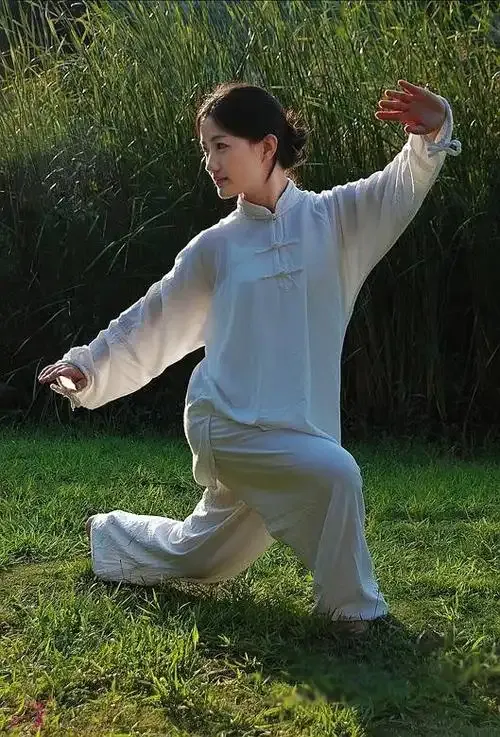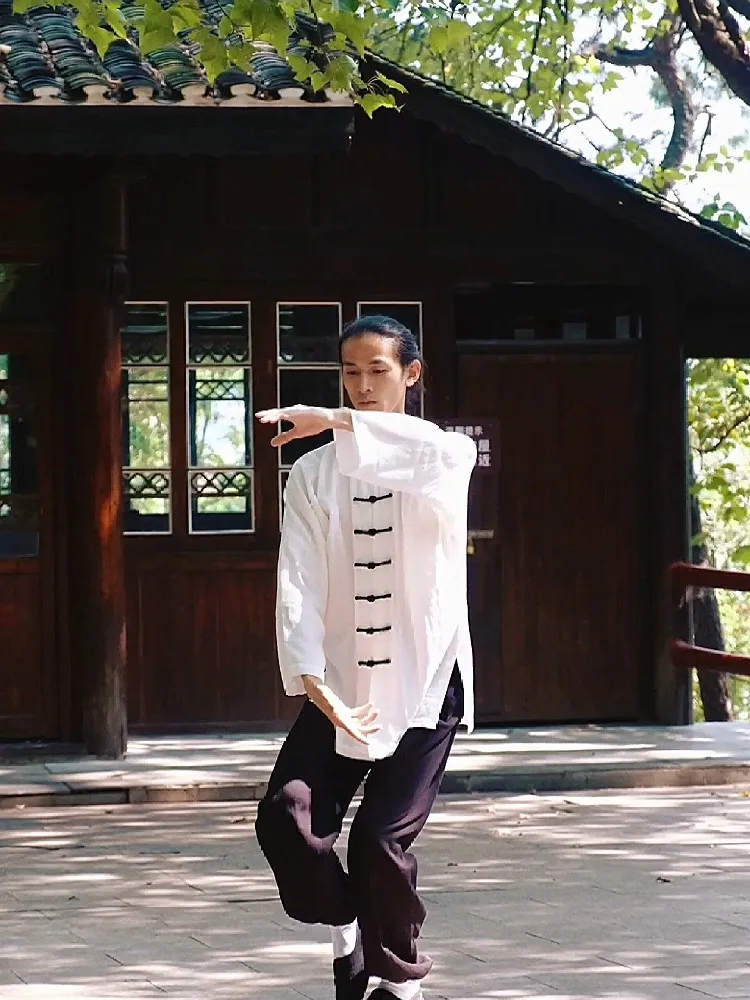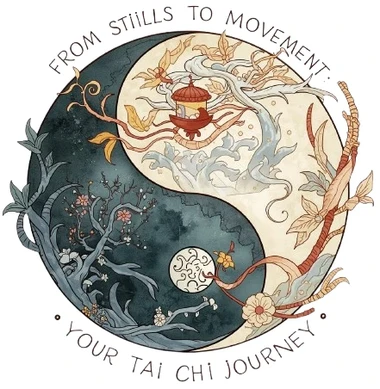Here at Taichi Wuji, we believe Tai Chi is more than a sequence of movements—it is a moving meditation, a dialogue between the body and mind.
The 16-Form, a concise and powerful sequence, serves as a perfect gateway to this ancient practice. It distills the essence of longer routines into an accessible yet profound discipline.
To support your practice, we have created a unique visual aid: a split-screen tutorial video showing both the front and back views simultaneously.
This guide is designed to dissolve the confusion of mirroring and help you grasp the postures with clarity.
Now, let us journey beyond the form to understand its soul.

The Philosophy of Balance: More Than Just Movement
The name "Wuji" (無極) refers to the primordial state of undifferentiated infinity, the great void from which Tai Chi (太極, the Supreme Ultimate) emerges. The 16-Form is a physical manifestation of this philosophy. Each movement is a exploration of the dynamic balance between Yin and Yang:
- Substance and Emptiness (实与虚): The continuous, mindful shifting of your weight from one leg to the other is the very practice of transitioning between solid (Yang) and empty (Yin).
- Expansion and Contraction (开与合): Movements like "Parting the Wild Horse's Mane" (Yang - expansion) are balanced by "Drawing Back" (Yin - contraction).
- Intent and Relaxation (意与松): Your mind leads with clear intent (Yi), while your body remains profoundly relaxed (Song), creating a powerful yet gentle flow.
As you practice, do not just perform the steps. Contemplate these principles. Feel the emptiness of one foot and the substance of the other. Sense the energy expanding to your fingertips as you open, and gathering to your core as you close.
Deconstructing the Form: Key Movements and Their Inner Meaning
Let's explore a few key postures from the 16-Form, connecting the external movement to the internal intention.
1. Commencing Form (起势 - Qǐ Shì)
This is where you establish your connection to Wuji. Stand with your feet rooted, crown of the head suspended, and mind calm. As you slowly raise and lower your arms, you are not just moving limbs; you are drawing the universal energy (Qi) from the earth and heaven, centering yourself before the dance of Yin and Yang begins.
2. Parting the Wild Horse's Mane (野马分鬃 - Yě Mǎ Fēn Zōng)
This classic posture is a masterclass in spiraling energy and rooted stepping. As you turn your waist and "part" the energy, visualize moving through a gentle resistance, like parting tall grass. The power comes from the waist (the axis), not the arms. Our dual-view video is crucial here, allowing you to see the precise footwork and hip rotation that creates this powerful, graceful movement.
3. Wave Hands Like Clouds (云手 - Yún Shǒu)
This is the embodiment of fluidity and continuous change, like watching clouds drift across the sky. The focus is on the smooth, coordinated turning of the waist and the soft, sweeping motion of the hands. The lower body provides a stable, rooted base while the upper body flows effortlessly. It teaches you to remain calm and centered amidst constant motion.
4. Closing Form (收势 - Shōu Shì)
Do not simply walk away. The closing form is as vital as the commencement. It is a ritual of gathering the energy you have cultivated during your practice and storing it in your lower dantian (energy center below the navel). This completes the cycle, returning you to a state of integrated wholeness.
The Symphony of Benefits: How the 16-Form Nurtures You
A consistent practice of the 16-Form offers a holistic symphony of benefits:
- Physical Harmony: Improves balance, coordination, and flexibility. It gently strengthens the legs and core while lubricating the joints.
- Mental Serenity: The required focus on movement and breath acts as a moving meditation, reducing stress and anxiety, and enhancing mental clarity.
- Energetic Flow (Qi): The slow, deliberate movements are designed to unblock and smooth the flow of Qi throughout the body's meridians, boosting vitality and supporting the immune system.
Your Path to Mastery: How to Practice Deeply
- Start with the Video: Use our split-screen tutorial to learn the basic roadmap of the form. Don't strive for perfection initially; focus on understanding the sequence.
- Practice in Sections: Break the form into the segments we've outlined. Master one section before moving to the next.
- Integrate the Principles: Once the sequence is familiar, begin to layer in the philosophical elements: weight shifts (substantial/insubstantial), waist turning, and mindful breathing.
- Practice Regularly: Even 15 minutes a day is more beneficial than a long session once a week. Consistency is the key to internalizing the art.

Begin Your Journey with Taichi Wuji
The path of Tai Chi is a lifelong journey of self-discovery. The 16-Form is your faithful companion on this path, offering endless depth beneath its simple surface.
We invite you to watch the video, step onto your practice space, and begin.
Deepen your practice. Explore our online courses and personalized guidance at Taichi Wuji.
- Did you find this guide helpful? Share your thoughts and questions in the comments section below.
- Want to see the forms in action? Watch our unique front-and-back tutorial on YouTube and subscribe to our channel for more content.
- Ready for the next step? Explore our structured online learning programs designed to take your practice to a deeper level.
Frequently Asked Questions: Tai Chi 16 Form
What is the difference between Tai Chi 16 Form and 24 Form?
The 16 Form is a shorter, more foundational sequence, often recommended as a starting point for absolute beginners. It covers essential stances and principles. The 24 Form (Simplified Tai Chi) is longer, incorporates more complex transitions, and is the standard competitive set. Think of the 16 Form as learning the alphabet before writing sentences.
How long does it take to learn the Tai Chi 16 Form for a beginner?
With consistent practice (e.g., 15-20 minutes, 3-4 times a week), a beginner can memorize the basic sequence of the 16 Form in 2-4 weeks. However, deepening your understanding of the internal principles, balance, and flow is a continuous and rewarding journey that can take a lifetime.
Can I learn Tai Chi 16 Form at home by myself?
Yes, you can certainly learn the basic movements at home using resources like our split-screen tutorial video. It's designed to make self-learning easier by eliminating the mirroring confusion. For finer details and personalized corrections, consider supplementing with online courses or occasional sessions with an instructor.
What are the main health benefits of practicing the 16 Form regularly?
>Regular practice offers a multitude of benefits, including: Improved balance and stability (reducing fall risk), enhanced mental clarity and reduced stress, increased joint flexibility and leg strength, better mind-body connection, and stimulation of Qi (vital energy) flow for overall vitality.
Do I need to be flexible or in good shape to start the 16 Form?
Not at all. Tai Chi is a low-impact, adaptable practice. The 16 Form is perfect for all fitness levels and ages. You start within your current range of motion and flexibility, and the practice itself will gently and naturally help you improve both over time. The focus is on slow, mindful movement, not exertion.
What should I wear and where is the best place to practice?
Wear loose, comfortable clothing that allows for free movement and flat, flexible-soled shoes (or practice barefoot on a non-slip surface). Find a quiet, spacious area indoors or a calm, flat spot outdoors where you won't be interrupted.
How does the front and back view help in learning?
Traditional videos force you to "mirror" the instructor, which can be confusing for footwork, hip direction, and arm angles. Our simultaneous front and back view provides a 3D perspective, allowing you to see the exact positioning from all angles at once, drastically reducing the learning curve and potential for error.
